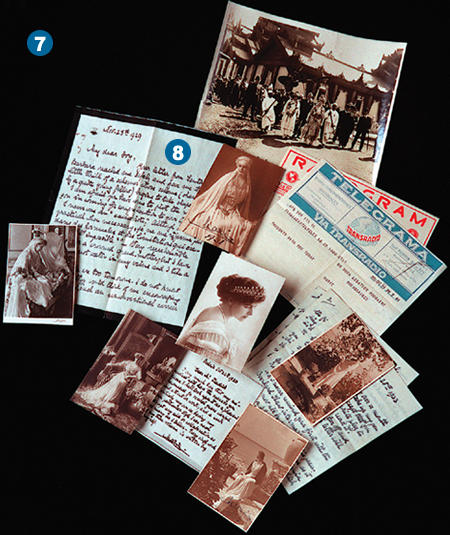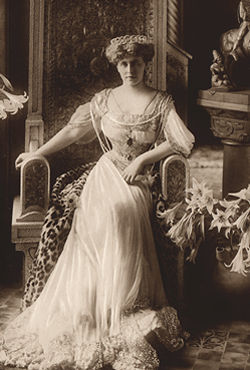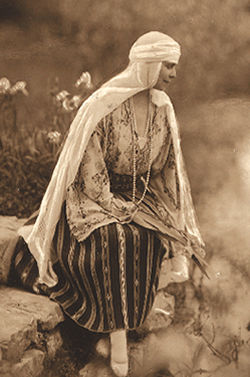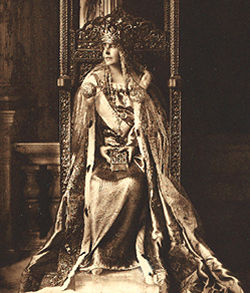Queen Marie of Romania, 1875–1938
 |
|
7. Several collections in the Hoover Archives document the unusual career of Marie of Romania. The daughter of Alfred, Duke of Edinburgh, and Grand Duchess Marie of Russia, she was one of the most intelligent and beautiful young royals of pre—World War I Europe. Marie’s paternal grandmother was Queen Victoria, and her maternal grandfather was Tsar Alexander II of Russia. She spent a protected childhood in England, Germany, and Malta, with occasional forays into the extravagant world of the Romanov court. Queen Victoria intended her to marry the British Crown prince, who was reportedly very pleased with the prospect. Instead Marie’s Anglophobe mother steered her into a marriage with Crown Prince Ferdinand of Romania, a new nation ruled by imported German royalty. Carol I of Hohenzollern-Sigmaringen ruled first as prince of Romania from 1866 to 1881 and then as king of the newly recognized nation from 1881 to his death in 1914. His nephew Ferdinand succeeded him in 1914 and with Marie saw Romania through the tragedy of World War I. Together they guided the consolidation of Transylvania with Romania in 1918. As the Ottoman, Hapsburg, and Russian empires crumbled around the Romanian lands, Ferdinand and Marie served an essential function in maintaining national unity. 8. Many of Queen Marie’s letters are preserved in the George Duca and Mother Alexandra papers in the Hoover Archives. |
 |
9. A formal portrait shows Crown Princess Marie soon after she married Ferdinand in 1893. Aged 17 at the time of her wedding, she moved into a country that lacked the wealth and stability she was used to in England. Against all expectations, she rose to the challenge. |
|
|
|
 10. Ferdinand and Marie ascended to the throne upon the death of King Carol I in 1914. Queen Marie is shown here in a traditional Romanian costume. Since her husband was uncomfortable and awkward in public, she happily filled the role of a unifying figurehead for the country. Her dramatic flair and affinity for Romanian art endeared Marie to her adopted country. Highly quotable, she said she was not sure that she was the most beautiful woman in Europe but she was definitely the most beautiful queen. A serious side to her nature deepened over time. Although her husband’s ties to Germany were strong, she helped maneuver the government into an alliance with the more popular British and French in 1916. In return for the enormous sacrifices caused by that alliance, Romania received vague promises of unification with Transylvania. When German and Austrian forces occupied over half the territory of the country during the war, Marie played a highly visible role as a nurse and made spirited public appearances to maintain morale throughout the desperate times. During the Paris Peace Conference at the end of the war, Romanian diplomats were often treated as second-class participants and the promised unification was very much in jeopardy. While Romanian leaders worked hard to secure implementation of Allied promises, Marie traveled to Paris and London, using her charisma and access to the press to ensure visibility for her country. In the end the Romanian negotiators were successful in uniting traditional Romanian lands into what is essentially the shape of the country as we know it today. |
 11. To celebrate and confirm the establishment of a greater Romania, including Transylvania, a coronation of King Ferdinand and Queen Marie was held in the ancient city of Alba Iulia on October 15, 1922. This photograph depicts Marie in her coronation robes and seated on an ornate throne. Much of the theatrical clothing used for ceremonial occasions was designed by Marie. After the death of Ferdinand in 1927, Marie was marginalized from public life by her son King Carol II. She devoted her time to projects such as writing her autobiography and continued writing her diaries, which are now in the Romanian National Archives in Bucharest. She spent her last years deeply concerned about the fate of Romania. Her intelligent but unpredictable son King Carol II, who renounced the throne on several occasions, lacked her leadership qualities, but Marie saw great promise in her grandson Michael. |







